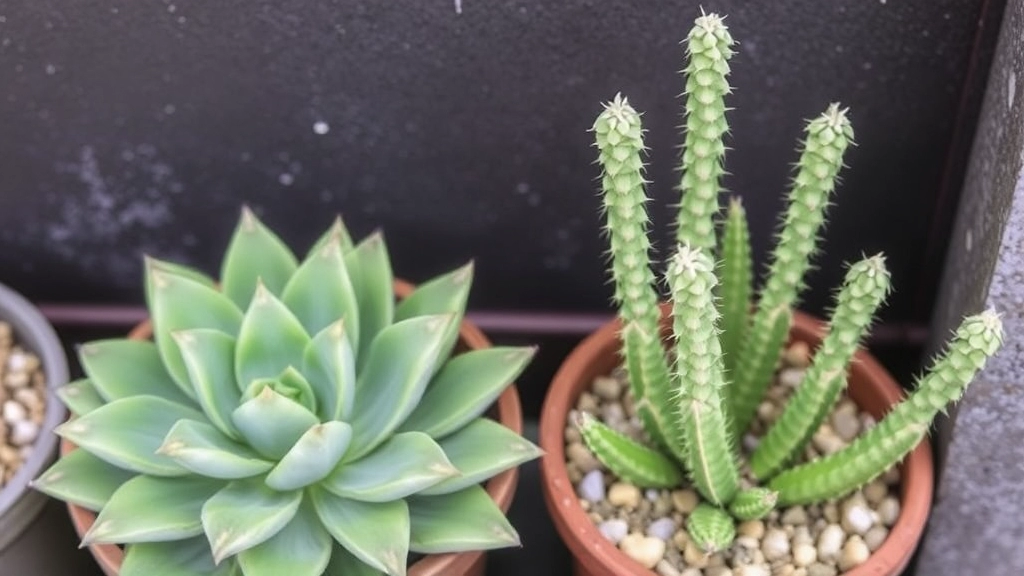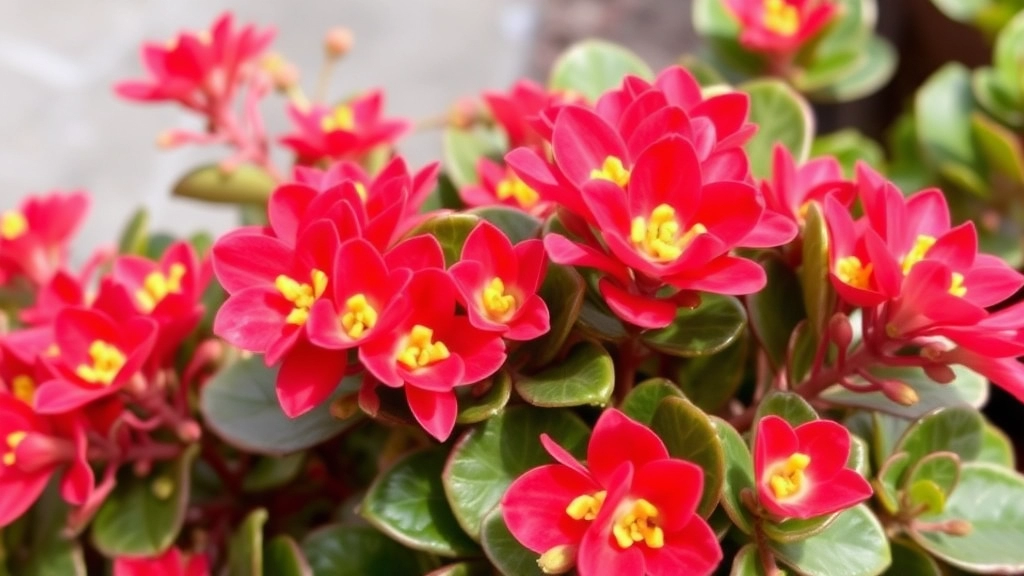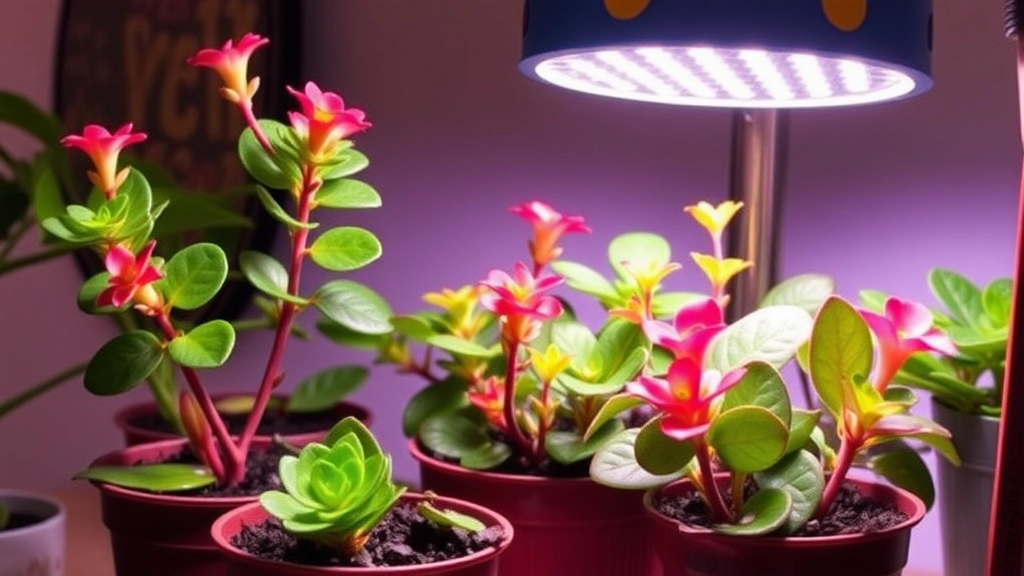Kalanchoe Blossfeldiana Etiolation
Have you noticed your Kalanchoe blossfeldiana looking tall, stretched, and leggy? This common issue, known as etiolation, often happens due to insufficient light. If your Flaming Katy is suffering from this, don’t worry—you’re not alone. Let’s dive into why this happens and how to fix it.
Understanding Etiolation
Etiolated Kalanchoe blossfeldiana can be a sign that your plant isn’t getting the light it needs. Improving lighting conditions, pruning, and other care tips can help restore its compact, healthy growth. Read on to discover practical solutions to bring your plant back to its best.
What is Etiolation?
Etiolation occurs when a plant stretches toward a light source, resulting in elongated stems and sparse leaves.
In Kalanchoe Blossfeldiana, this can lead to:
- Thin, elongated stems that appear weak.
- Sparse foliage, making the plant look unbalanced.
- Pale or yellowing leaves, indicating stress.
Signs to Look For
To effectively recognise etiolation in your Kalanchoe, keep an eye out for:
- Heightened growth with minimal leaf development.
- Leaves that are further apart on the stem than usual.
- Weak, floppy stems that struggle to support the plant’s weight.
Why Does This Matter?
Understanding these signs is crucial for timely intervention.
If left unaddressed, etiolation can compromise the health and aesthetic of your Kalanchoe. For more detailed care tips, check out our Kalanchoe Blossfeldiana leaf care tips and our guide on optimal care for Kalanchoe Blossfeldiana growth.
Causes of Leggy Growth in Succulent Plants

Ever noticed your Kalanchoe looking a bit taller and spindly than you’d like? You’re not alone. Leggy growth in succulent plants is a common concern, and it can be frustrating. So, what’s causing this lanky look?
1. Insufficient Light
The most common culprit is a lack of light. Succulents, like Kalanchoe Blossfeldiana, thrive in bright, indirect sunlight. When they don’t get enough, they stretch towards the light source, resulting in that leggy appearance.
2. Poor Soil Conditions
Another factor could be the soil. If it retains too much moisture, your plant may not grow as robustly as it should. Succulents prefer well-draining soil that allows their roots to breathe.
3. Overwatering
Speaking of moisture, overwatering can lead to root rot. When roots are unhealthy, the plant can’t support itself properly, leading to weak, elongated growth.
4. Lack of Nutrients
Nutrients matter too. If your Kalanchoe isn’t getting the right balance of nutrients, it could become weak and leggy. A good fertiliser can do wonders here.
5. Temperature Fluctuations
Extreme temperature changes can stress your plant. If it’s too hot or too cold, it might not grow as well, leading to that stretched-out look.
6. Natural Growth Cycle
Lastly, some leggy growth is just part of the plant’s natural growth cycle. As it ages, it might stretch out a bit.
How Lighting Affects Kalanchoe Blossfeldiana’s Growth
Have you ever noticed your Kalanchoe Blossfeldiana stretching awkwardly towards the light? This phenomenon is a clear sign that lighting plays a crucial role in its growth.
Understanding Light Requirements
Kalanchoe plants thrive in bright, indirect sunlight. Here’s how lighting impacts their growth:
- Photosynthesis: Adequate light is essential for photosynthesis, the process through which plants convert light into energy. Insufficient light can stunt growth and lead to leggy, etiolated stems.
- Flowering: Proper lighting encourages blooming. Kalanchoe requires around 12-14 hours of light daily to produce vibrant flowers.
- Leaf Health: Insufficient light can cause leaves to lose their rich green colour, turning pale and unhealthy. For more tips on maintaining healthy leaves, check out our Kalanchoe Blossfeldiana leaf care guide.
Types of Light Sources
- Natural Light: Position your Kalanchoe near a south or west-facing window for optimal exposure.
- Artificial Light: If natural light is limited, consider using grow lights. They can mimic sunlight and provide the necessary spectrum for growth.
Signs of Inadequate Lighting
- Stretched, leggy growth
- Pale or yellowing leaves
- Reduced flowering
Adjusting Light Conditions
To ensure your Kalanchoe thrives, monitor its light exposure regularly.
- Rotate the plant to ensure even light distribution.
- Consider moving it closer to a light source if you notice signs of distress. For additional care tips, see our optimal care guide for Kalanchoe Blossfeldiana.
Corrective Pruning Techniques for Etiolated Kalanchoe

If you’ve noticed your Kalanchoe Blossfeldiana growing tall and leggy, you’re not alone. Many plant enthusiasts face the challenge of etiolated succulents, and corrective pruning can be a game changer.
Why Prune?
Pruning not only helps to restore the plant’s natural shape but also encourages healthier growth. By cutting back the leggy stems, you can promote bushier foliage and more vibrant blooms.
Steps for Effective Pruning
- Assess the Plant:
- Identify the most affected areas. Look for long, spindly stems that lack leaves.
- Gather Tools:
- Use clean, sharp pruning shears or scissors to make precise cuts. This reduces the risk of infection.
- Make the Cuts:
- Trim back the leggy stems to just above a leaf node. This encourages new growth from that point.
- Aim to remove about one-third of the plant, but adjust based on how leggy it appears.
- Dispose of Cuttings:
- Consider propagating healthy cuttings. They can root easily in water or soil, giving you new plants to enjoy.
- Monitor Post-Pruning:
- After pruning, place your Kalanchoe in a well-lit spot. This helps it recover and promotes new growth.
Aftercare
Post-pruning care is crucial for recovery. Ensure your Kalanchoe receives adequate water, but avoid overwatering. A well-draining potting mix is essential.
Preventing Etiolation: Best Lighting Practices
If you’re concerned about your Kalanchoe Blossfeldiana becoming leggy, understanding the right lighting practices is essential. Many plant enthusiasts often wonder how to keep their succulents thriving without the dreaded etiolated growth.
Here are some best lighting practices to ensure your Kalanchoe remains robust and healthy:
- Bright, Indirect Light: Kalanchoe thrives in bright, indirect sunlight. Position your plant near a window where it can receive ample light without being scorched by direct rays.
- Rotate Regularly: To promote even growth, rotate your plant every few weeks. This helps all sides receive equal light exposure, preventing one side from becoming leggy.
- Monitor Seasonal Changes: During the shorter days of winter, consider moving your Kalanchoe to a sunnier spot or using supplemental lighting to maintain its health. For more detailed tips, check out our optimal care guide for Kalanchoe Blossfeldiana.
- Avoid Low Light Conditions: If your plant is in a dimly lit area, it may stretch towards the light, leading to etiolated growth. Ensure it has access to adequate light sources.
- Use Sheer Curtains: If your Kalanchoe is in direct sunlight, using sheer curtains can diffuse the light, providing the perfect balance of brightness without overwhelming the plant. For more insights, visit our leaf care tips and troubleshooting guide.
Using Grow Lights for Indoor Kalanchoe Plants

So, you’ve noticed your Kalanchoe Blossfeldiana is looking a bit leggy, and you’re wondering how to give it that boost it needs. One effective solution? Grow lights!
Why Consider Grow Lights?
If natural sunlight is limited in your home, grow lights can be a game changer. They mimic the sun, providing the right spectrum of light that your plant craves.
Here’s what you need to know:
- Types of Grow Lights:
- LED Lights: Energy-efficient and long-lasting.
- Fluorescent Lights: Great for seedlings and low-heat options.
- Incandescent Lights: Not the best choice; they can get too hot and waste energy.
- Placement Matters:
- Position your lights about 12-24 inches above your Kalanchoe.
- Adjust the height as your plant grows.
- Duration of Light:
- Aim for 12-16 hours of light per day.
- Use a timer to keep things consistent.
- Light Spectrum:
- Look for full-spectrum lights that cover both blue and red wavelengths.
- Blue light helps with vegetative growth, while red light encourages flowering.
By using grow lights, you can create a mini indoor garden that keeps your Kalanchoe thriving.
Other Care Tips to Keep Your Kalanchoe Blossfeldiana Healthy
After addressing the importance of lighting and corrective pruning, it’s essential to consider other care aspects that contribute to the overall health of your Kalanchoe Blossfeldiana.
FAQs About Etiolated Kalanchoe Blossfeldiana
What causes leggy growth in Kalanchoe Blossfeldiana?
Leggy growth in Kalanchoe Blossfeldiana is typically caused by insufficient light, poor soil conditions, overwatering, lack of nutrients, temperature fluctuations, or the plant’s natural growth cycle.
How can I prevent my Kalanchoe from becoming leggy?
To prevent legginess, ensure your Kalanchoe receives bright, indirect sunlight, use well-draining soil, avoid overwatering, provide the right balance of nutrients, and maintain stable temperatures.
What is corrective pruning, and why is it important?
Corrective pruning involves trimming back leggy stems to promote bushier foliage and healthier growth. It helps restore the plant’s natural shape and encourages vibrant blooms.
How do I properly prune a leggy Kalanchoe?
Effective pruning steps include:
- Assess the Plant: Identify long, spindly stems that lack leaves.
- Gather Tools: Use clean, sharp pruning shears or scissors.
- Make the Cuts: Trim back stems to just above a leaf node, removing about one-third of the plant.
- Dispose of Cuttings: Consider propagating healthy cuttings.
- Monitor Post-Pruning: Place the plant in a well-lit spot to promote recovery.
What aftercare is needed post-pruning?
Ensure your Kalanchoe receives adequate water without overwatering and use a well-draining potting mix to support recovery and new growth.
Can grow lights help my Kalanchoe thrive indoors?
Yes, grow lights can be highly effective for indoor Kalanchoe plants, especially if natural sunlight is limited. They provide the right spectrum of light to support healthy growth.
What types of grow lights are best for Kalanchoe?
The best options include LED lights (energy-efficient and long-lasting) and fluorescent lights (great for seedlings and low-heat options). Avoid incandescent lights as they can get too hot and waste energy.
How should I position grow lights for my Kalanchoe?
Place the grow lights about 12-24 inches above your Kalanchoe. Adjust the height as the plant grows to ensure it continues to receive adequate light.
How many hours of light does my Kalanchoe need daily?
Aim for 12-16 hours of light per day. Using a timer can help maintain a consistent lighting schedule.
What light spectrum is ideal for Kalanchoe growth?
Full-spectrum lights that cover both blue and red wavelengths are ideal. Blue light aids in vegetative growth, while red light encourages flowering.
References
-
Common Problems with Kalanchoe
-
Kalanchoe Plant Care
-
Growing Kalanchoe
